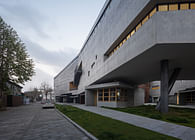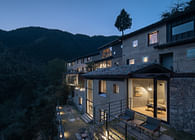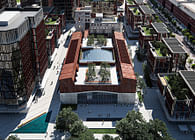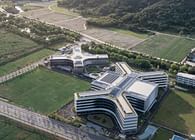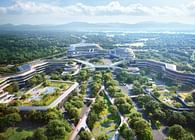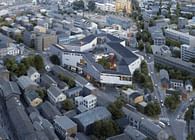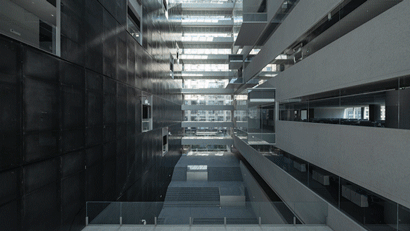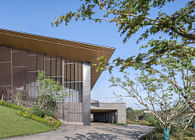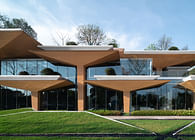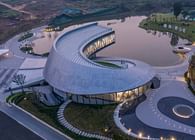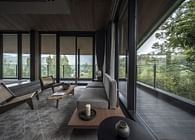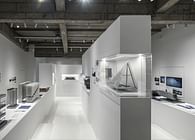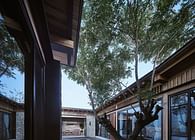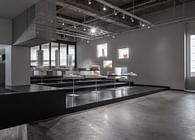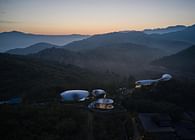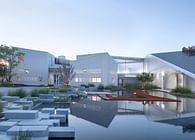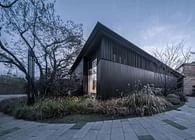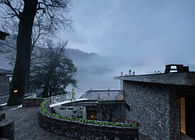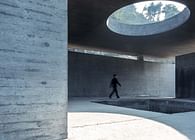
For traditional villages, protection is for better development, and development can realize its real protection. In the background of changes in the building system and building materials, we hope to provide exemplary renovation strategies for Miao Village dwellings while maintaining a good relationship between the new life needs and the traditional context. In addition, we take the opportunity to revitalize its culture and handicrafts, and establish a good commercial system. In the future, it will grow up organically at its own pace, thus realizing a real poverty alleviation.
-Meng Fanhao
Longtang village is located in Leishan County, southeast Guizhou Province, where the tea terraces are shrouded in clouds and mist, and the hanging wooden buildings fall on the cliff. The unsophisticated Miao villagers have lived here for generations, following the simple and natural mode of life. However, Longtang, which is included in the list of traditional Chinese villages, gradually declined due to the decline of industrial development and hollow of the population, which led large number of villagers to seek employment opportunities outside.
Since November 2013, the important idea of "targeted poverty alleviation" was proposed for the first time, and it has become the basic strategy of poverty alleviation in China. Under the guidance of this concept, the practice of targeted poverty alleviation in China has been continuously promoted. Guizhou Miao Village Mountain House is Sunac’s first project devoted into the public welfare practice of beautiful rural revitalization and targeted poverty alleviation. Based on the comprehensive experience of line + in the field of rural revitalization, Sunac China and the Youcheng Foundation of the State Council Poverty Alleviation Office jointly entrust line + to go deep into Longtang and reshape the village.
The construction area of the project is 2400 m2, including 1650 m2 of incremental building and 750 m2 of existing building for renovation, the incremental part of which is composed of 8 single buildings of guestrooms and restaurants, Cliff Theater, Infinity Pool and other public areas, with the construction of hiking trails and landscape restoration, so as to drive life and production lines of the whole village as well as the future development of the cultural and tourism industry streamline.
01
Facing up to the new demands of traditional rural life
In the course of its research, we found that Longtang village is facing a common problem faced by many traditional village – spontaneous reconstruction: the traditional aluminum alloy doors and windows were sealed to protect against the cold weather, and the ground floor that was originally stacked with farm tools was expanded into houses and toilets using modern materials such as cement and bricks. “The traffic in the village is getting convenient, and some basic modern building materials are easy to buy,” the village secretary said, “villagers have been renovating their houses in recent years, but experts who came to visit said we were doing damage.”
Indeed, it is to some extent an artificial invasion of traditional buildings, but in further thinking, this might result from their real needs. The old wooden stilts with local materials can no longer meet their basic needs for living.
These seemingly contradictory issues: traditional residential and modern living needs, traditional style and new industrial materials, traditional crafts and new industries, ideals and reality, extremely low cost budgets and high quality expectations. As architects, we attempt to make an answer to this traditional Miao village.
Respecting the history and embracing the future – create a demonstration of residential reconstruction for villagers in the Scenery Conservation Area; outside the Scenery Conservation Area, set a boutique homestay with a sense of contemporary and futuristic but without losing the core of the natural spirit of stilted buildings – achieving the parallel design of inventory and incremental buildings. While improving the quality of villagers’ life, line+ tries to connect the thread of settlement and culture of the Miao Village, bringing flux and vitality to the poor villages hidden in the mountains, and activating the self-energizing ability of the villages.
02
“Response and General” – Existing Buildings Reconstruction
The renovation is based on the in-depth study of the traditional stilted buildings at a cost similar to that of the villagers’ spontaneous renovation, and meets the villagers’ lifestyle and personal demands. We hope the design strategy which not only solves the problem but also maintains the cost unchanged can become a model for villagers to rebuild their own houses and protect the local context.
Balancing the conflict between traditional buildings and new needs, and weakening the heterogeneity brought by modern materials are the first considerations for the design team. The demonstration reconstruction design maximizes the retention and utilization of the original building structure and facade materials, and integrates the modern toilets, kitchens, farm tool storage and other living functions needed in the contemporary life of the villagers into the original building’s stilt floor and on one side of the building. At the same time, part of the overhead area is set aside to provide places for villagers’ daily needs such as sheltering, shading, socializing, parking, etc.; the roof space continues the village style and adds sloped roofs, which also provides a ventilated and sheltering roof drying area. Finally, it is also expected to bring green and clean energy to the village by solar photovoltaic panels.
Thanks to the local materials, as well as the simplification of structure and construction technology, the cost of the demonstration reconstruction scheme is similar to that of the villagers’ self-renovation, and the final result is recognized by the villagers and imitated by them. Fifteen local villagers took this as a model to carry out their own house renovation, achieving a point-to-face exemplary promotion, and the self-rejuvenation from invasion to restoration that responds to needs.
03
“Growth and Dialogue” – New Buildings
Mountain House is born on the ridge like the traditional stilts. In resolving the height difference, the design renders a guest room settlement that do not interfere with each other’s sight. The location and the Scenery Conservation Area are separated but overlook each other, as if the past and the future of the Miao Village echo each other.
The shape of the guestroom building is evolved from the traditional Miao stilted building. The bottom of the building is elevated and separated from the mountain to meet the needs of ventilation and moisture prevention. In addition, the equipment is hidden underneath. The overall building volume can be suspended on the top of the hillside forest, which seems indistinct when observed from a distance while be in intrinsic to the mountain when observed in a close distance. The entrance of each guestroom building is at the intersection of the building and the mountain, using the topography to create a clever three-dimensional appearance.
During the construction of the guestroom buildings, there is no opposition between light and heavy, but mutual achievement. Due to the difficulty of site construction, we originally planned to express the lightness of the building through prefabrication of steel structure. However, under limited cost conditions and after communicating with local construction personnel, we finally changed it to a heavy but inexpensive reinforced concrete structure.
The building volume floats on a mountain slope of nearly 45°. Contemporary materials such as glass and metal plates are used together with local materials such as rubble, blue tiles and wood. With the building volume separated from the foundation and the material texture integrated into the forest, the "heavy" of the building structure is eliminated. This design touch based on local conditions uses modern construction techniques to translate the characteristics of traditional stilted buildings fitting the mountain terrain.
The public building of Mountain House breaks through the traditional rural building styles, trying to create a refined and pure modern sense to dialogue with the mountains. The building is naturally divided into two L-shaped volumes according to the height differences with the mountain. They are connected and interlocked with each other. The upper part is protruding towards the distant mountain, and the lower part leads to the slope. According to the mountain shape, a flowing boundary is formed, embedded in the mountain and forest, with an abstract dialogue with the traditional Miao Village.
The staggered interlocked L-shaped volumes maximize the interface of the landscape, forming two outdoor landscape terraces with different height differences. The upper roof terrace is for appreciating the humanistic and natural scenery of the village. The lower roof plan is used for an outdoor theater and an infinite swimming pool.
Considering the mountain conditions and the complexity construction process of curved surface, the main building adopts a steel structure system, whose exterior is wrapped with metal aluminum panels, and the interior and indoor interfaces leave a cavity to fill with lightweight thermal insulation and waterproof materials. The whole structure is processed in the factory and hoisting is completed on site. The construction is simple and fast, and the transportation is convenient and safe. This choice also fully addresses the lack of precision in rural site construction and the complex conditions of mountain construction.
04
Targeted Poverty Alleviation under Value Overflow
Nowadays, Longtang is regaining the vitality of the village and has achieved comprehensive progress from "life" to "production". For more than two years, Sunac and Youcheng China Social Entreprenuer Foundation have taken their own advantageous industries and resources to protect the foundation of the village’s ethnic culture and traditional lifestyle through cultural tourism, industry driving, cultural activation, and education assistance, and established a long-term development mechanism of "helping the poor without returning to poverty". The Longzhitang Rural Tourism Professional Cooperative was established in the village, and INN helped its development with professional operating experience, including excavating the material cultural heritage of the village, revitalizing the traditional crafts, assisting in the operation of restaurants, producing cultural and creative products, operating intangible cultural heritage workshops, etc., which have provided the long-term good development momentum for the village.
From “poverty alleviation” to “rejuvenation”, the phased results of Longtang Rural Practice have aroused widespread attention from the society. Media such as CCTV, Xinhuanet, China News, World Wide Web, CNBN, Beijing Commercial Daily, etc. have separately reported the development of Longtang’s poverty alleviation and revitalization, and the coverage of the online platform “Yitiao TV” on Longtang has achieved over 100000 views. The social influence generated by the medium of architecture has enabled Longtang to achieve sustained growth after it was put into operation, which promoted the continuous increase in income, stable poverty alleviation, and gradual prosperity of the entire village. The poverty-stricken village of that year has now become a model village.
Construction is not an overnight process. Rural revitalization is a vision that can only be achieved through the joint efforts of multiple parties. line+ joins the front line of poverty alleviation from the perspective of an architect and cope with the practical problems arising from the underdevelopment of the traditional Miao village. With the demonstration effect of the inventory buildings and driven by the incremental buildings, the intuitive needs were addressed within geographical and economic constraints, and the village was energized, so that it can renew itself and develop in an orderly manner in the transformation to modern new lifestyles.
Project Name: Guizhou Longtang Targeted Poverty Alleviation Project
Project Location: Longtang Village, Leishan County, Guizhou Province
Planning and Design Unit: gad · line+ studio
Chief Architect/Project Principal: Meng Fanhao
Design Team: Liang Xi, Zhu Mingsong, Zhang Hanqi, Tu Dan, Shi Shangliu, Dai Shengxuan (Architecture), Jin Xin, Zhang Zhendong, Li Chonghao (Interior), Li Shangyang, Jin Jianbo, Chen Xiaorong, Zhang Wenjie (Landscape)
Building Area: 2400 m2 (new buildings 1650 m2, renovation 750 m2)
Design Period: 2018/08-2019/08
Construction Period: 2019/08-2020/10
Structural Electromechanical Design Unit: Zhejiang Greenton Architecture Design Co., Ltd.
Design Team: Ren Guangyong, Li Gen, Tang Xuchao (Structure), Wu Wenjian, Li Xiang (Water), Cui Daliang, Zhong Tianli (HVAC), Lu Baiqing, Cao Jun (Electrical)
Clients: Sunac China, Youcheng China Social Entreprenuer Foundation, Longtang
Village Committee Cooperative
Operator: INN
Photographer: Arch-Exist Photography
Status: Built
Location: Guizhou, CN
Firm Role: Architect
Additional Credits: Planning and Design Unit: gad · line+ studio
Chief Architect/Project Principal: Meng Fanhao
Design Team: Liang Xi, Zhu Mingsong, Zhang Hanqi, Tu Dan, Shi Shangliu, Dai Shengxuan (Architecture), Jin Xin, Zhang Zhendong, Li Chonghao (Interior), Li Shangyang, Jin Jianbo, Chen Xiaorong, Zhang Wenjie (Landscape)
Structural Electromechanical Design Unit: Zhejiang Greenton Architecture Design Co., Ltd.
Design Team: Ren Guangyong, Li Gen, Tang Xuchao (Structure), Wu Wenjian, Li Xiang (Water), Cui Daliang, Zhong Tianli (HVAC), Lu Baiqing, Cao Jun (Electrical)
Clients: Sunac China, Youcheng China Social Entreprenuer Foundation, Longtang
Village Committee Cooperative
Operator: INN







